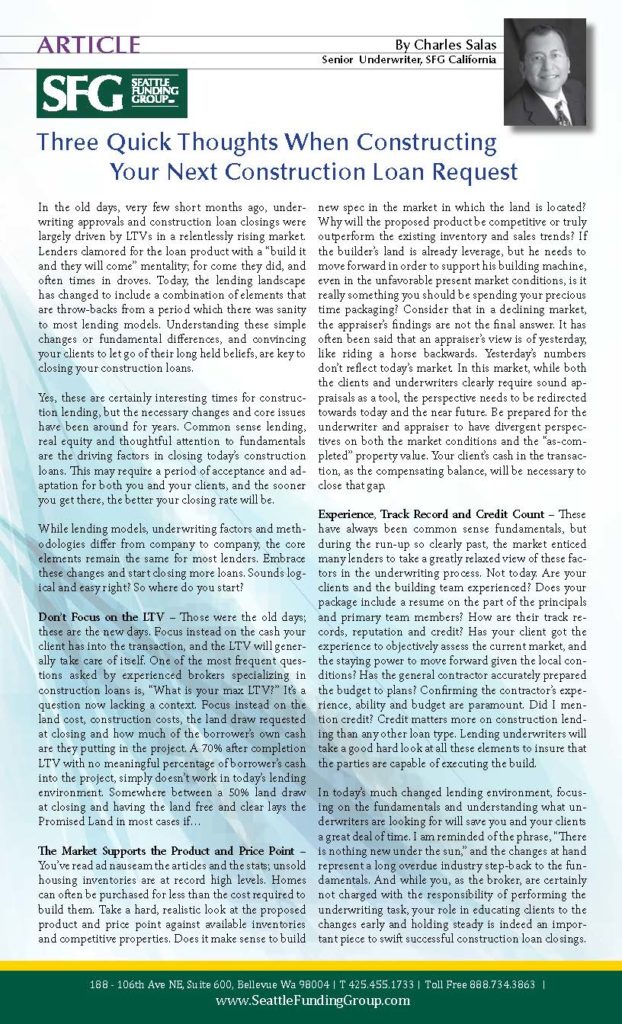By Charles Salas,
Sr. Underwriter, Seattle Funding Group of California
In the old days, very few short months ago, underwriting approvals and construction loan closings were largely driven by LTVs in a relentlessly rising market. Lenders clamored for the loan product with a “build it and they will come” mentality; for come they did, and often times in droves. Today, the lending landscape has changed to include a combination of elements that are throw-backs from a period which there was sanity to most lending models. Understanding these simple changes or fundamental differences, and convincing your clients to let go of their long held beliefs, are key to closing your construction loans.
Yes, these are certainly interesting times for construction lending, but the necessary changes and core issues have been around for years. Common sense lending, real equity and thoughtful attention to fundamentals are the driving factors in closing today’s construction loans. This may require a period of acceptance and adaptation for both you and your clients, and the sooner you get there, the better your closing rate will be.
While lending models, underwriting factors and methodologies differ from company to company, the core elements remain the same for most lenders. Embrace these changes and start closing more loans. Sounds logical and easy right? So where do you start?
Don’t Focus on the LTV
Those were the old days; these are the new days. Focus instead on the cash your client has into the transaction, and the LTV will generally take care of itself. One of the most frequent questions asked by experienced brokers specializing in construction loans is, “What is your max LTV?” It’s a question now lacking a context. Focus instead on the land cost, construction costs, the land draw requested at closing and how much of the borrower’s own cash are they putting in the project. A 70% after completion LTV with no meaningful percentage of borrower’s cash into the project, simply doesn’t work in today’s lending environment. Somewhere between a 50% land draw at closing and having the land free and clear lays the Promised Land in most cases if…
The Market Supports the Product and Price Point
You’ve read ad nauseam the articles and the stats; unsold housing inventories are at record high levels. Homes can often be purchased for less than the cost required to build them. Take a hard, realistic look at the proposed product and price point against available inventories and competitive properties. Does it make sense to build new spec in the market in which the land is located? Why will the proposed product be competitive or truly outperform the existing inventory and sales trends? If the builder’s land is already leverage, but he needs to move forward in order to support his building machine, even in the unfavorable present market conditions, is it really something you should be spending your precious time packaging? Consider that in a declining market, the appraiser’s findings are not the final answer. It has often been said that an appraiser’s view is of yesterday, like riding a horse backwards. Yesterday’s numbers don’t reflect today’s market. In this market, while both the clients and underwriters clearly require sound appraisals as a tool, the perspective needs to be redirected towards today and the near future. Be prepared for the underwriter and appraiser to have divergent perspectives on both the market conditions and the “as-completed” property value. Your client’s cash in the transaction, as the compensating balance, will be necessary to close that gap.
Experience, Track Record and Credit Count
These have always been common sense fundamentals, but during the run-up so clearly past, the market enticed many lenders to take a greatly relaxed view of these factors in the underwriting process. Not today. Are your clients and the building team experienced? Does your construction loan package include a resume on the part of the principals and primary team members? How are their track records, reputation and credit? Has your client got the experience to objectively assess the current market, and the staying power to move forward given the local conditions? Has the general contractor accurately prepared the budget to plans? Confirming the contractor’s experience, ability and budget are paramount. Did I mention credit? Credit matters more on construction lending than any other loan type. Lending underwriters will take a good hard look at all these elements to insure that the parties are capable of executing the build.
In today’s much changed lending environment, focusing on the fundamentals and understanding what underwriters are looking for will save you and your clients a great deal of time. I am reminded of the phrase, “There is nothing new under the sun,” and the changes at hand represent a long overdue industry step-back to the fundamentals. And while you, as the broker, are certainly not charged with the responsibility of performing the underwriting task, your role in educating clients to the changes early and holding steady is indeed an important piece to swift successful construction loan closings.
Click for more information about Seattle Funding Group’s Construction Loan Program

